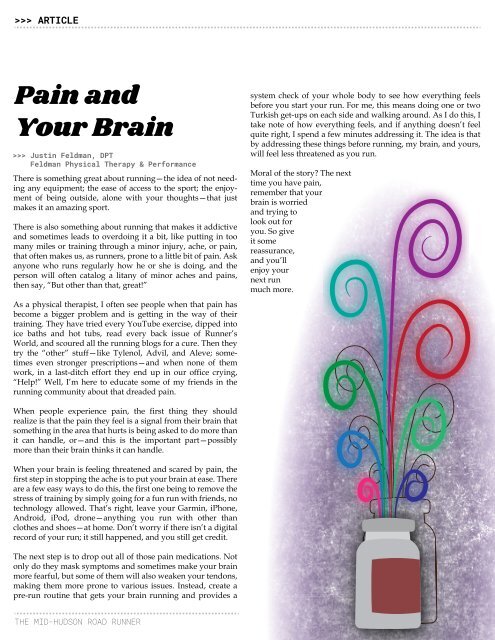Fall 2016 Draft 3
Create successful ePaper yourself
Turn your PDF publications into a flip-book with our unique Google optimized e-Paper software.
ARTICLE<br />
Pain and<br />
Your Brain<br />
>>> Justin Feldman, DPT<br />
Feldman Physical Therapy & Performance<br />
There is something great about running—the idea of not needing<br />
any equipment; the ease of access to the sport; the enjoyment<br />
of being outside, alone with your thoughts—that just<br />
makes it an amazing sport.<br />
There is also something about running that makes it addictive<br />
and sometimes leads to overdoing it a bit, like putting in too<br />
many miles or training through a minor injury, ache, or pain,<br />
that often makes us, as runners, prone to a little bit of pain. Ask<br />
anyone who runs regularly how he or she is doing, and the<br />
person will often catalog a litany of minor aches and pains,<br />
then say, “But other than that, great!”<br />
As a physical therapist, I often see people when that pain has<br />
become a bigger problem and is getting in the way of their<br />
training. They have tried every YouTube exercise, dipped into<br />
ice baths and hot tubs, read every back issue of Runner’s<br />
World, and scoured all the running blogs for a cure. Then they<br />
try the “other” stuff—like Tylenol, Advil, and Aleve; sometimes<br />
even stronger prescriptions—and when none of them<br />
work, in a last-ditch effort they end up in our office crying,<br />
“Help!” Well, I’m here to educate some of my friends in the<br />
running community about that dreaded pain.<br />
system check of your whole body to see how everything feels<br />
before you start your run. For me, this means doing one or two<br />
Turkish get-ups on each side and walking around. As I do this, I<br />
take note of how everything feels, and if anything doesn’t feel<br />
quite right, I spend a few minutes addressing it. The idea is that<br />
by addressing these things before running, my brain, and yours,<br />
will feel less threatened as you run.<br />
Moral of the story? The next<br />
time you have pain,<br />
remember that your<br />
brain is worried<br />
and trying to<br />
look out for<br />
you. So give<br />
it some<br />
reassurance,<br />
and you’ll<br />
enjoy your<br />
next run<br />
much more.<br />
When people experience pain, the first thing they should<br />
realize is that the pain they feel is a signal from their brain that<br />
something in the area that hurts is being asked to do more than<br />
it can handle, or—and this is the important part—possibly<br />
more than their brain thinks it can handle.<br />
When your brain is feeling threatened and scared by pain, the<br />
first step in stopping the ache is to put your brain at ease. There<br />
are a few easy ways to do this, the first one being to remove the<br />
stress of training by simply going for a fun run with friends, no<br />
technology allowed. That’s right, leave your Garmin, iPhone,<br />
Android, iPod, drone—anything you run with other than<br />
clothes and shoes—at home. Don’t worry if there isn’t a digital<br />
record of your run; it still happened, and you still get credit.<br />
The next step is to drop out all of those pain medications. Not<br />
only do they mask symptoms and sometimes make your brain<br />
more fearful, but some of them will also weaken your tendons,<br />
making them more prone to various issues. Instead, create a<br />
pre-run routine that gets your brain running and provides a<br />
THE MID-HUDSON ROAD RUNNER



